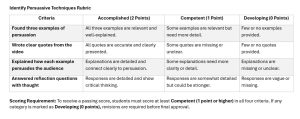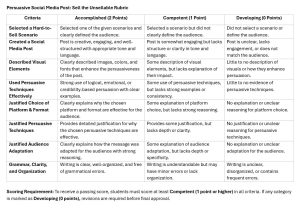Applying Your Skills: Persuasive Techniques
Now it’s time to put your communication skills into action. To complete this section, you will choose and complete ONE of the two activities below. Both options allow you to demonstrate your understanding of key communication competencies while providing flexibility in how you showcase your skills.
Each activity is designed to align with the principles of Universal Design for Learning (UDL), meaning you have the freedom to select the format that best suits your strengths and interests. Within your chosen activity, you may also encounter additional choices to further personalize your learning experience.
Once you have successfully completed your chosen activity, follow the instructions to review your work using the provided self-assessment criteria and submit your final version within the forms below.
If you have any questions during this process, feel free to reach out to Dr. Christine Crefton at christine.crefton@montgomerycollege.edu for guidance.
Activity 1. Identify Persuasive Techniques
Objective:
The goal of this exercise is to help students recognize and analyze different persuasive techniques used in a speech. By identifying examples of logical appeals, emotional appeals, and audience adaptation, students will develop a deeper understanding of how persuasion works in communication.
Instructions:
- Watch the video and pay close attention to how the speaker tries to persuade the audience.
- Find three examples of persuasion from the video.
- Fill out the form with three examples of persuasion from the video.
- Answer the reflection question.
- Use the rubric to check your work and ensure you meet all the criteria for a strong response.
1. Logical Appeal (Facts & Evidence)
- Quote from the video: “This information is from the American College Health Association… 84.3% of students felt overwhelmed, 60.5% felt very sad…”
- How it persuades: The speaker uses numbers and facts to make their argument stronger. This helps the audience trust what they are saying.
2. Emotional Appeal (Feelings & Stories)
- Quote from the video: “After all of that, I feel like all my ideas will be rejected… my day was ruined by my parents.”
- How it persuades: The speaker tells a personal story to make the audience feel sympathy. This makes people connect with their message.
3. Speaking to the Audience
- Quote from the video: “Parents, we need you when we’re feeling down… we want your encouragement to help us conquer difficulties by ourselves.”
- How it persuades: The speaker talks directly to parents, making them feel important. This makes them more likely to listen.
Now it’s your turn…
Find three more examples of persuasion in the video and complete the form:
Activity 2. Persuasive Social Media Post: Sell the Unsellable
Objective:
Create a persuasive social media post promoting a product, idea, or cause to an unlikely audience. You will need to craft a compelling message that uses persuasive techniques such as logical reasoning, emotional appeals, and audience adaptation. Refer to the rubric for scoring criteria.
Instructions:
- Pick a Challenge: Choose from one of the following “hard-to-sell” scenarios:
- Selling bubble gum to the teachers’ association
- Selling lawn chairs to airlines
- Selling flip-flops to Antarctic researchers
- Selling a pet goldfish to a busy CEO
- Selling a lifetime supply of pickles to a dessert shop
- Selling a luxury yacht membership to college students on a budget
- Create a Social Media Post: Design an engaging post for your product on a social media platform of your choice. Consider the following:
- Platform & Format: Will you use Instagram (image + caption), Microblogging Platform like X (short, persuasive thread), Video Creation Platform like TikTok (video script), or Facebook (detailed post)?
- Visual Elements: What images, colors, or fonts will make your post eye-catching?
- Persuasive Techniques: Will you appeal to logic (data and facts), emotion (storytelling and humor), or credibility (testimonials and authority figures), etc.?
- Tone & Language: How will you adapt your message to fit their audience?
- Justify Your Choices: Please explain:
- Why you chose the platform and format.
- The persuasive techniques used and why they are effective.
- How you adapted your approach to the specific audience.
Example:
Scenario: Selling Snowplows to Hawaiians
Instagram Post: A vibrant beach scene with a snowplow clearing sand off a road, accompanied by the caption:
“Think snowplows are just for winter? Think again! 🌴🏖️ Our all-terrain snowplows double as the ultimate sand removers—keeping Hawaiian roads, driveways, and resort paths clear all year long! Say goodbye to clogged beach roads and hello to smooth driving! #SnowplowForSand #IslandReady #ClearTheWay”
Persuasive Techniques Used: Humor, problem-solution framing, and repurposing the product for a unique use case to make it appealing.
Reflection Justification:
“I chose Instagram because it allows for a visual representation of an unexpected yet practical use of snowplows in Hawaii. The humor makes the post engaging, and I adapted the language to emphasize how the product can solve a real problem—sand buildup on roads. The hashtags also help make it more shareable for a broader audience.”
Now it’s your turn…
Complete the form:



